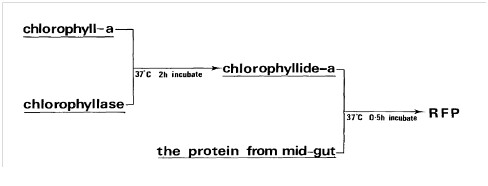Authors: Ashish Marathe1, Rakeshkumar Prajapat2, Deepak Pawar2
1 Ph.D Scholar, Division of Biochemistry, IARI, New Delhi-110012
2 Ph.D Scholar, N.R.C.P.B, IARI, New Delhi-110012
The silkworm Bombyx mori has been exploited as a silk producer in the silk industry for thousands of years. Sericulture is an important agro-based industry. India ranks second next to China among the silk producing countries of the world having an area of 0.2 million hectare under mulberry cultivation, producing 14,048 million tonnes of raw silk (Anon, 2002). The importance from the national perspective is its valuable foreign exchange earning capacity, to the tune of 900 crore rupees. The industry also offers employment to 6 million people and is suited to small and marginal farmers with small landholdings since it is highly labour intensive and provides a regular source of income.
Silkworm is susceptible to fungal, bacterial, viral and protozoan diseases. B.mori nucleopolyhedrosis virus (BmNPV) is the most harmful virus in the sericulture industry, often causing severe economic losses (Ponnuvel et al., 2003). Silk produced by multivoltine races is inferior to that produced by the bivoltine races. BmNPV infection is one major hurdle in trying to establish bivoltine sericulture in India and it is estimated that 40-50% crop losses occur in sericulture due to this disease. High temperature with high humidity is conducive for proliferation of this disease. Insects have self defense system against invading microorganisms as that of vertebrates. But, insects seemingly lack any adaptive immune responses that operate analogously to the well documented antibody or histo-compatibility adaptive immune responses as in vertebrates. Like other kinds of insects, the silkworms have an efficient innate immune system which can recognize an invading organism as foreign object followed by activation of its antiviral peptides. Apoptosis is one of the phenomenon evolved by some invertebrates lacking humoral immunity to function as antiviral defense mechanism (Narayan, 2004). The mechanism is a controlled biochemical pathway distinguishable from cell necrosis by characteristics that include cellular shrinkage and membrane blebbing (Wyllie et al., 1980). Insect immunity plays an important role in the interaction between the host and pathogen as a part of survival strategy including physical blockades cellular responses such as phagocytosis and also production of certain antimicrobial and antiviral peptides.
Owing to its antiviral property, a red fluorescent protein (RFP) complex has an important role in the immune system of the silkworm. The silkworm RFP’s are familiar for their antiviral activity against B. mori nucleopolyhedrosis. So far, the silkworm RFP’s identified, are well-known only for their antiviral activity but no information on their antibacterial and antifungal activity is available in literature. Various RFP’s such as 65 kDa (Sethuraman et al., 1993), 24 kDa serine protease (Nakazawa et al., 2004), 30kDa lipase RFP (Ponnuvel et al., 2003) and recently a 302 kDa lipocalin (Mauchamp et al., 2006) have been so far reported. Thirty five years ago, Japanese scientist studied the biochemistry and biological properties of a red fluorescent protein produced by the mid gut of silkworm. They assigned antiviral properties to this protein. They revealed that the red fluorescence is due to the binding with chorophyllide a, the prosthetic group of cholorophyll. This cholorophyllide results of the activity of cholrophyllase, released from the mulberry leaves during silkworm feeding (Mauchamp et al., 2006). Recent success of transgenesis of the silkworm has opened new prospects for this insect species (Tamura et al., 2000).
Biosynthesis of RFP: In the synthesis of this protein, chlorophyll-a of mulberry leaves is first converted into chlorophyllide-a by chlorophyllase under the action of light and is further synthesized in the midgut cells and released into the midgut to form RFP. Chlorophyllase catalyses the hydrolytic cleavage of the phytol moiety from chlorophyllide setting free phytol and chlorophyllide. The porphyrine ring of chlorophyllide breaks out from chlorophyllide to change into bile pigment. For this reaction, light and oxygen are most necessary. Both chlorophyll-a and chlorophyllase are essential for RFP synthesis. Chlorophyllide-a pigment can be conjugated unspecifically with more than one midgut protein, with the ingested chlorophyll merely providing a pigment moiety for RFP biosynthesis.

Diagramatic representation of biosynthesis of RFP
Conclusion:
The silkworm B.mori has good innate defense system against invading pathogens namely viruses, bacteria and fungi. Several antiviral factors have been reported that act against such pathogens, RFP is one of them. Database information of this protein is limited, to use a reverse genetics approach to study this protein further. It will therefore, be interesting to isolate the protein, deduce the amino acid sequence and try to get to the gene which can then be used in various ways like developing transgenics or expression in bacteria and then use the proteins for management of viral diseases in silkworms. Further since a few insect proteins are reported to be effective against human pathogens like HIV and HSV, similar attempts can be made with this protein.
About Author / Additional Info:
Ph.D Scholar in the Division of Biochemistry